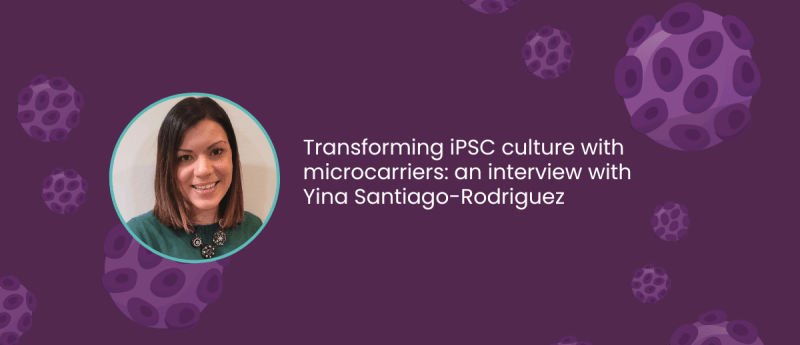Transforming iPSC culture with microcarriers: an interview with Yina Santiago-Rodriguez

Yina Santiago-Rodriguez gives an overview of microcarrier-based hiPSC scale-up. Yina explains how to overcome challenges by optimizing environmental conditions within the bioreactor to maximize hiPSC differentiation potential. Yina also gives recommendations for improving the quality control of cell cultures.
This interview is part of the RegMedNet In Focus on expansion and downstream processing of hiPSCs. Discover expert opinions on this topic by visiting our feature homepage.
Meet the interviewee
Yina Santiago-Rodriguez, Process Development Manager, FUJIFILM Cellular Dynamics, Inc. 
Yina is a Process Development Manager at Fujifilm Cellular Dynamics International (FCDI; WI, USA) with over 15 years of experience in cell culture process development in support of pre-clinical and commercial operations. Over the last six years Yina’s primary focus has been on platform technology development of cell culture systems, upstream process development of iPSC-derived products and development of cell washing and concentration unit operations.
FCDI strives to revolutionize healthcare by harnessing the power and potential of the human cell to improve the quality of lives of patients around the world.
Questions
iPSCs have traditionally been cultured as adherent cultures in 2D planar culture vessels, which is limiting for multiple reasons. When culturing iPSCs or any other cell type as adherent cultures, scale is limited by the available surface area. Since the cells must attach to a surface for survival, the only way to generate more cells is to provide more surface area. In traditional 2D planar systems the footprint required to obtain a large number of iPSCs can be quite large, even when using vertically stacked multilayer vessels. Not only does this consume a lot of incubator space, but handling all of these vessels is challenging from an operational perspective and risks contamination if you’re using open systems. Furthermore, since such culture systems are typically static, gas supply, especially oxygen, can become a challenge and undesirable gradients can form in the culture for media components, paracrine factors, and waste products. iPSCs are highly sensitive to their environment and culturing them under non-optimal conditions can significantly impact their ability to differentiate.
Microcarriers are an attractive option for the scale-up of adherent iPSC cultures because they have a much larger surface-area-to-volume ratio than standard 2D planar culture vessels, enabling greater space efficiency. Furthermore, microcarriers are small enough that they can be put into dynamic suspension with gentle agitation. This is important because it provides the opportunity for adhesion-dependent cell types to be cultured in controlled bioreactor systems, which offers a significant improvement for both scale-up and process control.
We have developed proprietary protocols for culturing iPSCs on microcarriers. Briefly, the cells are attached to the microcarrier under static conditions, then agitation initiates and the cultures are allowed to expand or differentiate over the process duration. At the end of the process the cells are detached then separated from the microcarriers and harvested for further differentiation or cryopreservation. The key to our successful microcarrier cultures is understanding how the cells are responding at each step of the process and determining and controlling the critical process parameters.
Compared to traditional 2D static culture processes, FCDI’s microcarrier-based processes, coupled with an automated bioreactor system, provide a controlled environment that improves the availability of elements such as oxygen and can maintain a closer homeostatic state for the culture over time. Microcarrier- based cultures enable a direct path to scale-up within a bioreactor platform system, significantly increasing the batch yield potential and maximizing space efficiency. Moreover, our method also facilitates process integration of closed systems for downstream processing.
The scale-up potential is what excites me most about microcarrier-based culture. To realize the full potential that iPSCs offer to treat human diseases, we need to be able to generate large numbers of functional cells at a reasonable cost. This is simply not possible with traditional culture systems, but microcarrier-based systems offer a pathway to the scale-up needed.
On a personal note, I am drawn to microcarriers and iPSC scale-up in general because of the complexity of the challenges. There are so many factors that can impact how an iPSC grows and differentiates and they’re all connected; in tuning one factor you can inadvertently modify another, which can have a big impact on the final product. During initial development stages, not only for the development of new cell types (iPSCs, differentiated cells, etc.,) but also to be able to produce them at a meaningful scale, trying to tackle these challenges can be overwhelming. I am always excited to work with, develop and implement innovative technologies, especially when we can provide an improved solution and increase our company’s capabilities, process understanding, and process innovation.
Process and platform understanding is crucial, as it will be nearly impossible to implement a new platform for iPSC culture when the baseline process is not well -understood. Transitioning from traditional 2D static culture systems to microcarrier-based processes requires more sophisticated bioprocesses and it’s not always straight forward to anticipate limitations that the platform and process may have to control key process parameters. We need to be able to assess the impact the platform may have on the process throughout the development and scale-up.
When culturing iPSCs under dynamic suspension, finding the balance between providing sufficient oxygen to the cells without overdoing it with shear stress is also really important. Other cell types like CHO can probably handle greater shear stresses without impacting their growth or function, but iPSCs are very sensitive to shear. This is one reason we really like the PBS vertical wheel technology; it provides good mixing properties while at the same time being gentle on the cells.
The process of expanding iPSCs and differentiating them towards various cell types will differ from cell type to cell type and sometimes from line to line, and each culture process may have distinct tolerance and operating windows. To optimize the environmental conditions in the bioreactor for a microcarrier–based culture, the first step is to establish the baseline process profile and identify key process parameters that need to be maintained throughout the transition from a 2D static process to a microcarrier– based process in the bioreactor. Second, use small–scale models of the bioreactor to establish procedures that can maintain those key process parameters while keeping in mind the operating window and limitations of the target scale system. Lastly, assess process impact via characterization profile and ability of the culture to perform in the subsequent differentiation stage.
Harvesting cells from microcarriers is another hurdle to overcome for iPSCs and should be evaluated carefully. If you can generate lots of cells using microcarriers, but you can’t efficiently harvest the cells from them, then you’ve lost a lot of their benefit. Like with traditional 2D static culture systems, harvesting cells from the microcarriers will usually involve an enzymatic detachment step to separate the cells form the microcarrier, followed by filtration, wash and concentration steps. We will screen a variety of release agents for each type of cells and perform several tests to characterize the harvested cells and assess for damage.
We’ve also looked at dissolvable microcarriers and believe they have a lot of potential for being a gentler means of cell harvesting.
Establish a standard baseline process that you can rely on and always run it side by side.
With any new cell culture process, you are testing to provide comparability.
Perform some level of in-process characterization to trend your processes and try to determine what a ‘normal’ culture looks like, for instance, by measuring metabolites.
Run kinetic studies where cells are harvested and assessed with cell counts, flow cytometry, and any other method you deem important to gain an understanding of how the culture progresses over time. This is especially important when differentiating iPSCs.
Ensure that any analytical method used to assess cell culture outcomes can be reliably executed across scales.
Disclaimer
The opinions expressed in this interview are those of the interviewee and do not necessarily reflect the views of RegMedNet or Future Science Group.
In association with

